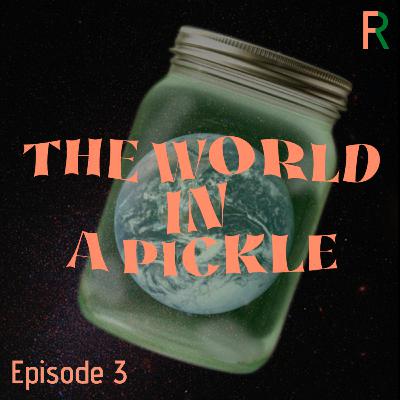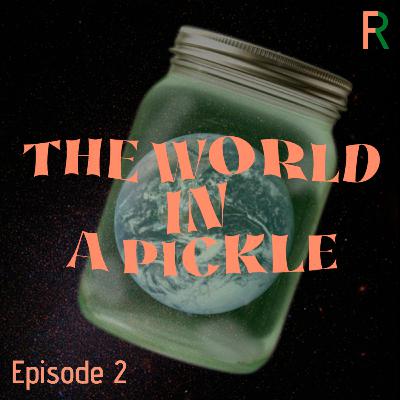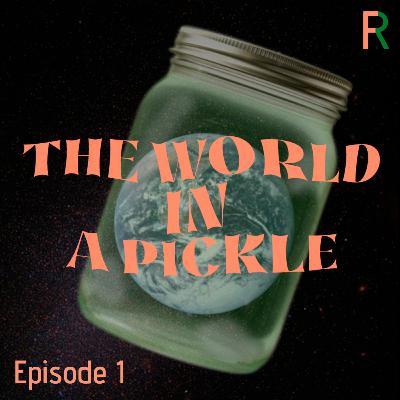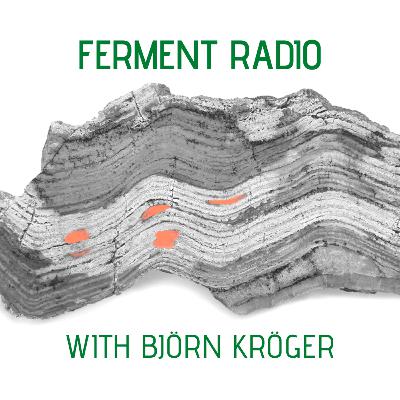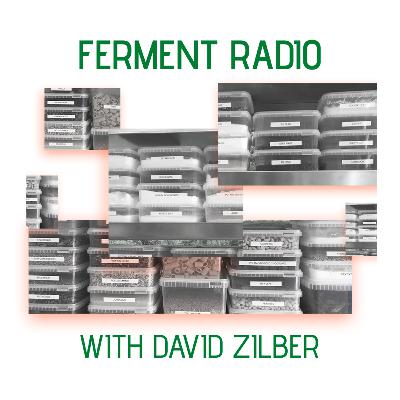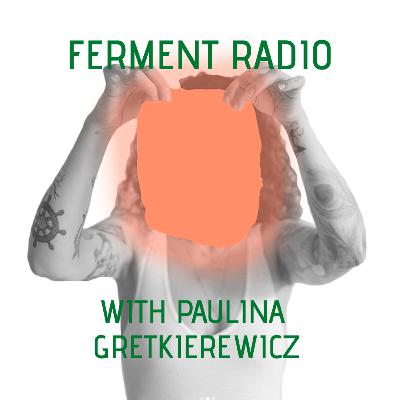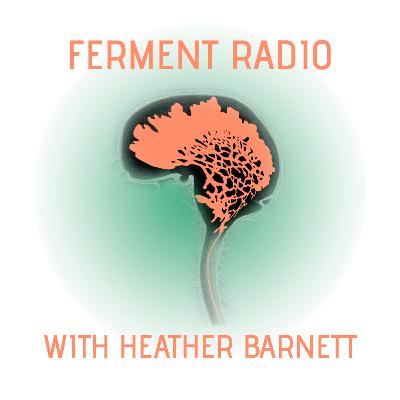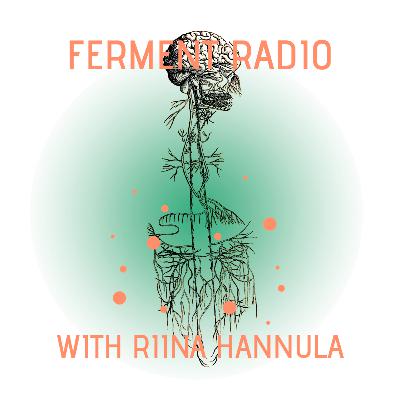Discover Ferment Radio
Ferment Radio

52 Episodes
Reverse
If you send a mixture of soybeans and koji mold to outer space, will it ferment as miso, even so far away from home?How do you bring it back to Earth? How will it taste like? Can we still call it miso?This is the second part of our conversation with Joshua Evans, from the Sustainable Food Innovation at the Danish Technical University’s Center for Biosustainability. We had previously talked about how miso was sent to space. In this episode, we will find out how it returned to Earth, and what fermenting in space means to earthly food systems.Get ready for a techy and scifi’sh episode, where we learn more about designing an experiment that implies sending fermented food to outer space.
There’s a phenomenon experienced by people who have seen the Earth from outer space. It is known as the “Overview Effect”: a new level of compassion and understanding of how fragile and interconnected life is. What could bring us closer to the Overview Effect without leaving Earth? How can we embody what is hard to grasp, relate to, and integrate into a conscious interconnectedness beyond intellectual understanding? What if, instead of looking from far away, as in the Overview Effect, we looked into ourselves from a microscopic close-up? Could we get closer to a sense of expanded consciousness within the Earth’s ecosystem and beyond our simplified identities?These are the questions that led me to develop the project “Insideview”, an audio-visual ritual to compost human exceptionalism, performed in January 2025, at Helsinki’s SOLU space. Together with an amazing team that included Aga Bułacik, Vaim Sarv, and Ola Zielińska, we intertwined folk songs, ferments, words, and holographic projections of the human microbiome to set on a dreamy journey to re-imagine our relationship with the living world, both within and around us. Drawing inspiration from death doulas who use songs to create safe spaces for letting go, we hummed along to hospice human exceptionalism and confront our fears of insignificance.
When humans go to space, whether they like it or not, microbes tag along. And if microbes can live in microgravity—probably more comfortably than humans—then perhaps fermented food too.There have already been a few experiments to send fermented foods into orbit—like kimchi and wine. But there’s a difference between eating food that was fermented on Earth, and fermenting it in space. This is where people like Joshua Evans come in. Joshua leads the research group on Sustainable Food Innovation at the Danish Technical University’s Center for Biosustainability. Together with Maggie Coblentz and their team, Joshua was responsible for sending miso into outer space. That’s right, we’re talking about the traditional Japanese seasoning made with fermented soybeans and koji mold.On this episode of Ferment Radio, we’ll walk you through all the steps needed to ferment in space. Why would anyone want to ferment miso in outer space in the first place?
Did you know your body is never truly sterile—even before you’re born? From semen and placenta to umbilical cord blood, your microbial journey begins early on. And it doesn’t stop there. The type of birth, nurturing, and how you explore the world as a child play a crucial role in shaping your unique microbiome. The introduction of solid foods, interactions with your environment, and social contact add even more layers of complexity. By adulthood, your gut microbiome reaches its peak flexibility and resilience—but its foundations are built much earlier in life.As a young child, you explore the world with your hands, mouth, and curiosity—interacting constantly with an invisible universe of microbes. However, science has only recently started to seriously explore the deep and complex relationships between children and microbes.One pioneering initiative is the Microbial Childhood Collaboratory—an international, interdisciplinary research group exploring the concept of the biosocial child: not merely as an individual, but as an ecological being, deeply entangled in microbial and biospheric communities that sustain life. One of their projects, Microbial Childhood: Restor(y)ing Daycare Ecologies, emerges from research and experimentation around the design of a microbial-friendly daycare in Tampere, Finland.The Collaboratory brings together community artists, environmental ecologists, sociologists, anthropologists, and early childhood education researchers—including Dr Jan Varpanen, Dr Mira Grönroos, Erika Aalto, Eva Bubla and Zsuzsa Millei, Professor of Early Childhood Education at Tampere University, who joins us in this episode.
In this episode of the World in a Pickle, we delve into the world of pulque—a fermented drink made of agave sap, or “aguamiel”, which has been consumed in Mexico for centuries, and is now threatened by urbanization, climate change, and crime.Our guests, César Iván Linares, an ethnobiologist specialized in traditional fermented beverages, and Juan Escalona Meléndez, a chef and scientist behind projects like Coyota, share their work with ESPUMA—an initiative dedicated to keeping pulque alive.Through a fusion of biology, agroecology, and creativity, ESPUMA builds a resilient ecosystem around fermentation. They harvest urban agaves in and around Mexico City and cultivate new plants on a micro-farm. They also work closely with pulqueros, the people who make and sell pulque, and tlachiqueros, who harvest the agave sap, to preserve their precious knowledge and create a strong community around this beverage. But what makes ESPUMA truly special is how they blend science with pulque-making. Instead of bringing pulque into the lab, they bring microscopes to pulque farms.Welcome to “To exist you have to resist”, the fourth episode of The World in a Pickle, Ferment Radio’s mini-series focused on understanding geopolitical complexities through fermented foods.
The Guarani-Kaiowá are the people of Mato Grosso do Sul, a Central-West region of Brazil. It translates as “Thick Forest of the South", and as the name suggests, nature has protected the Guarani-Kaiowá and their culture from colonization. Particularly, the ancient tradition of chicha making—a sacred white corn drink that can also be fermented. The Guarani-Kaiowá believe that if they stop making chicha, the world will end. Today, this thick forest has been turned into a vast monoculture of soy plantations, and the Guarani-Kaiowá have nowhere to go and continue their ancestral cultural practices. Perhaps the end of the world is closer than ever.
Join us on a fermentation journey with Paula Neubauer, a Brazilian award-winning chef and educator, as we explore the complexity of sacred fermented chicha and the fascinating people who make it.
Welcome to “The End of Many Worlds”, the third episode of The World in a Pickle, Ferment Radio’s mini-series focused on understanding geopolitical complexities through fermented foods.
When Russia started to claim ownership over the ever popular –and oftentimes fermented– soup known as Borscht, Ukrainian chef Yevhen Klopotenko knew he had to do something. He took up a knife, chopped up some beetroots, added a few more ingredients, and turned them into a soup. Then he traveled across Ukraine to find out where this dish comes from. If he could only confirm its origins, UNESCO could protect Ukrainian Borscht, winning a battle on the food front against cultural appropriation. Why is Borscht so important? Join us on a fermentation journey through the intricacy and diversity of this beloved soup.
Welcome to the 2nd episode of the World in a Pickle, Ferment Radio’s mini-series focused on understanding geopolitical complexities through fermented foods.
Migrating birds, shipwreck survivors, extraterrestrial bodies, distant seeds washed ashore, outsiders in love, forgotten memories, and rare ingredients that become staple foods. This is Hiiumaa, an island in the Baltic Sea, 22 kilometers from mainland Estonia: a field laboratory to investigate “what is foreign”. In collaboration with plants, flavors, human voices, and insular soundscapes, we ferment a sonic journey to discover what it means to become a local.
This is the 1st episode of the World in a Pickle, Ferment Radio’s mini-series focused on understanding geopolitical complexities through fermented foods.
You enter a restaurant in a historical art nouveau building, right in the center of Helsinki, Finland. You sit down and a person wearing a stylish uniform, made of discarded textiles, pours water into a glass that is made out of a used bottle. You look around and wait for your food. There’s not a single trash bin. Instead, there is a stainless steel, sci-fi-looking piece of furniture, which turns out to be a composter nicknamed Lauri. Finally, your dish comes on a plate made from waste clay. It looks and it tastes delicious. Your food is waste-free too.
Welcome to Nolla, the first zero-waste restaurant in the Nordic countries. In this episode, we chat with one of its founders Albert Franch Sunyer about establishing and running a zero-waste restaurant, with a little help from microbes, of course.
Two hundread years ago, the very first illustration of prehistoric times –in a scientific context– was brought to light. It was painted by British geologist and palaeontologist Henry De la Beche, who was inspired by fossils collected by Mary Anning. The artwork, known as “Duria Antiquior, a more ancient Dorset”, cuts through costal waters to depict the epic – and strangely simultaneous– battles between different marine species.
But, hey, wait a minute! Did these species ever meet? Why are they so violent? How come there are no depictions of cyanobacteria “dominating” the planet 3 bilions years ago? Maybe this representation tells us more about humans than about prehistoric animals.
Welcome to a brand new episode of Ferment Radio full of stories to be retold, deep time, cyanobacteria, and the inevitable fate that awaits all species: extinction. We are guided by Björn Kröger’s expertise in marine paleoecology, paleobiology, and his interest in the history and philosophy of Earth sciences. Björn is also the Curator of the Paleontological Collections at the Finnish Museum of Natural History in Helsinki, and a docent at the University of Helsinki, Finland.
Let´s take a trip in time!
Bacteria are often considered ugly and stinky; something dangerous that wants to get on us, and that we need to protect ourselves from. Fermentation is one way to overcome that prejudice and find pleasure and beauty in what many people fear, misunderstand, or even loathe. Another way is art, which can utilize microorganisms as metaphors and aesthetic experiences. But, do things need to be pretty so they can talk to us?
In this episode of Ferment Radio, we go on a journey through the artistic work of Anna Dumitriu. Her interdisciplinary practice merges art, science, and technology to explore issues around health, disease, and the societal impact of scientific progress. Anna collaborates closely with scientists and historians, incorporating biological materials like bacteria and DNA into her installations, sculptures, and performances. Through her work, she invites viewers to reconsider common perceptions of the natural world.
We choose our tools, and in return, our tools shape us. Tools can be an opening to new possibilities, but also a limitation. What makes the workspace of a fermenter? What tools are there available? How do these tools influence the process?
In this episode, we sneak peek into the kitchen of David Zilber, chef, fermenter, food scientist, and author of The Noma Guide to Fermentation. Guided by David’s voice, and powered by imagination, we stroll around his lab at Chr. Hansen in Hørsholm, Denmark.
This is the second part of our interview with David Zilber. Check out episode 36 to learn more about the importance of “little” ferments in the “big” food system.
It looks like a square, monochromatic, glass slide photo, and not only because of the material it is made of, but also because it could belong to a different time. It feels as if the face that emerges from there and gazes at you must have posed for a very long time for the exposure to do its job. Only if you could stare at it uninterruptedly for days, or years, would you be able to notice that the image is in constant change. It is alive. It comes from nowhere, and disappears into what comes next. It is called yeastogram.
Yeastograms are living images made of yeast cultures growing on agar plates and carved with UV light. One of the people who have mastered this technique is Johanna Rotko, a visual artist based in Lahti, Finland. Yeastograms are a lot about fine-tuning the technology. But it goes beyond that. It is also about bringing the imagery of deceased people back to life, waiting for the uncontrollable to do its job, killing and letting live. In other words, it is about time. It is about patience.
She asks the plants for permission before foraging them. She sings to her fermentation jars. She prepares funerals for her kombucha scobies. She gives names to her ferments. She observes the moon cycles. She’s a witch. But what does it mean to be a witch today?
I asked this to Paulina Gretkierewicz, a forager, a fermenter, and a witch. She transforms seasons and landscapes around Copenhagen, Denmark into edible and drinkable experiences. She calls this “Applied Poetry”, which is also the name of her business, focused largely on handpicked, fermented, and oxidized teas.
Let’s ferment our way into becoming a witch.
Have you ever heard of slime mold?
These organisms might not have a nervous system or even a brain, but they have impressive problem-solving abilities. Slime mold can navigate through mazes and find the most efficient routes to find food. Some researchers have already been inspired by them to design more efficient transportation networks, urban planning, and solving optimizational problems. However, they are shrouded in a haze of mystery. They are hard to like, observe, and classify.
In this episode, together with Heather Barnett, an artist and university professor at Central Saint Martins University of the Arts London, working with natural phenomena, complex systems, and playful pedagogies, we look at slime mold beyond their instrumental features and focus on their intrinsical importance as a remarkable lifeform. Instead of thinking: What can we extract from these species? We want to ask ourselves: What can we actually learn from them?
Join us in this fascinating and meandering, or shall we say, “slimemoldesque” conversation.
A healthy food system encourages the production and consumption of foods that support a balanced gut microbiome. It reduces food waste and gives preference to natural preservation methods. It uplifts food, not only for its nutritional value but also as cultural heritage and an expression of diversity. It is also mindful of the energy spent in order to process food.
All these characteristics of a healthy food system sound very much like the definition of fermented foods. It may seem like a simple solution, but diagnosing and improving the complexity of the food system, which is both global and fragmented, is a huge challenge.
There are not that many people in the world who can say they have extensive hands-on experience working in different areas of that vast system. David Zilber is definitely one of them. From a butcher shop in Toronto to the Fermentation Lab of the acclaimed restaurant Noma, Copenhagen, and to the labs of Chr. Hansen, a giant bioscience company in Hørsholm, Denmark, David Zilber has garnered multiple and fascinating perspectives on food and the system around it. Ferment Radio had the pleasure to talk with David in his own lab, where we reflected more about this incredible journey and his ever-evolving views on the food system that we are all part of.
Garden. It invites us to sit down and watch things grow. It makes us work with gazillions of other species to make them flourish. Silent observation or site-specific, mindful labor can be a form of wondering: seeing magic in what’s common and perceiving what’s repetitive with new eyes.
This is how Noora Sandgren, a visual artist and art educator from Finland, works in her family garden. She collaborates with climates, insects, and expired light-sensitive material to create cameraless photograms of shared chemistry of composting organic matter, microbes, human breaths, and sunlight.
In this episode, Noora takes us to her garden where she wonders while taking lensless images and patiently waits for long exposures for the magic to happen.
We associate these institutions with petrified displays, and long-gone worlds that are alien to our own experience: museums. Whether we like it or not, they play a crucial role in preserving heritage.
Can heritage be something alive and ever changing? It seems that yes. At least ARTIS-Micropia, a one-of-a-kind museum showing the invisible world of micro-organisms, is doing that. ARTIS-Micropia is a museum in Amsterdam in which visitors can learn more information about microbes, and see live microbes on display too.
The museum fills a gap between the general public’s knowledge on microroganisms, and the science behind microbiology. “Unknown is unloved” they say on their webpage, and they definitely want to change that.
On Ferment Radio’s new episode, we talk with ARTIS-Micropia’s lab technicians Loek van Buuren and Eline van Bloois about curating microbes, preserving what is alive, and dreaming about immersive microscopial experiences, which could allow us to float with microbes in their micro universe.
Can we intentionally influence our nervous system through what we do? If so, could we also activate the main nerve of our parasympathetic nervous system known as vagus nerve? This is the central communication pathway between the gut and the brain, and between microbiota and our nervous system. Could we interact with our gut microbiota and our gut microbiota interact with us?
In this episode of Ferment Radio, together with Riina Hannula, we start with Microbial Medi(t)ation, an instructional audio that guides us through selected movements from yin- and hatha yoga to stimulate the vagus nerve. With this meditation, we wonder if it is possible to embody scientific facts and if our well-being involves the well-being of our microscopic companions as well.
Riina Hannula, an artist and doctoral student in sociology at The Centre for the Social Study of Microbes at the University of Helsinki, studies humans as holobionts from a gut-brain-axis point of view and looks into how microbes think, feel, and behave with humans.
We communicate with the outside world based on the information we receive through our senses. But just like fingerprints, no two people have the same brain anatomy, and therefore, no two people can sense the world identically. We can’t experience how other bodies feel, but we can attempt to describe it.
Today, together with Pia Lindman, an artist and researcher working with performance art, healing-as-art, installation, microbes, architecture, painting, and sculpture, we dive into the uniqueness of bodily experiences; even those caused by microorganisms. Pia calls this, the subsensorial.







